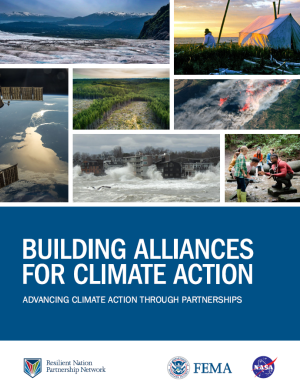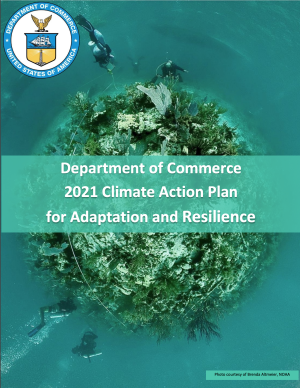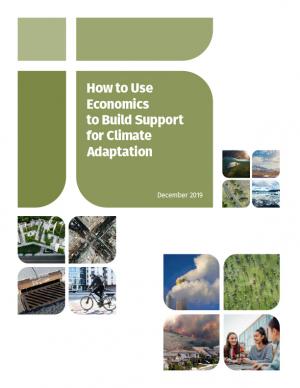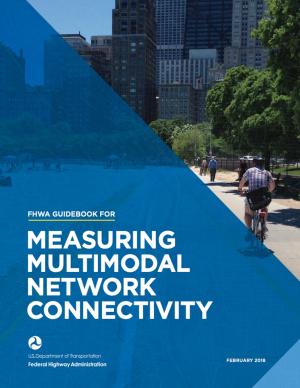Access a range of climate-related reports issued by government agencies and scientific organizations. Browse the reports listed below, or filter by scope, content, or focus in the boxes above. To expand your results, click the Clear Filters link.
To become climate resilient requires collective action. Our efforts must take a Whole-of-Government and Whole Community approach.
The Resilient Nation Partnership Network is working to address this through partnership. The result of our collective action is this Building Alliances for Climate Action resource. It is the work of many organizations and individuals, including federal representatives, faith leaders, community-based organizations, mayors and many more. At a time when many are searching for direction on how to address the climate crisis, this resource represents a unifying voice, helping guide the Whole Community forward
Executive Order 14008, Tackling the Climate Crisis at Home and Abroad, requires that each Federal agency develop a Climate Action Plan for Adaptation and Resilience. This plan highlights the important role the Department of Commerce plays in advancing climate adaptation and resilience. The actions captured in this Plan, as well as the broader work of the Department to address the climate crisis, support the Department’s mission to create the conditions for economic growth and opportunity.
Sections in this report include:
- Why Is Climate Adaptation & Resilience Planning Important for the Department of Commerce?
- Efforts to Enhance Climate Literacy into the Management Workforce
- Climate Vulnerability Assessment
- Actions to Enhance Climate Adaptation and Resilience with Climate-Ready Sites and Facilities
- Actions to Enhance Climate Adaptation and Resilience with Climate-Ready Products and Services
- Priority Climate Adaptation and Resilience Actions
This report presents recommendations for how state governments can develop climate-resilience financial systems that help local communities invest in protecting residents, businesses, public infrastructure, private property, and natural resources from climate-driven stresses and shocks. To help states consider and act on the recommendations, a State Climate Resilience Action Checklist (page 50) identifies the essential actions that states need to take to build a comprehensive approach to resilience, including a financial system. The report also offers an Inventory of Climate Resilience Actions.
A growing number of local governments are taking steps toward climate adaptation, mostly through the development of climate adaptation plans. However, the rate and pace of adaptation action has significantly lagged behind planning, especially in mid- and small-sized municipalities where resources are often limited and local politics may further delay action. This report describes how to use economics to build support for climate adaptation. Using case studies from cities large and small, it highlights how to effectively use economic data and methods, provides eight types of economic analyses for climate adaptation, and explains how to clearly communicate economic data to different audiences.
The guidance provided by this report is designed to help all communities create disaster debris management plans. It assists communities in planning for natural disaster debris before disasters—such as hurricanes, earthquakes, tornadoes, volcanoes, floods, wildfires, and winter storms—occur by providing useful, relevant information intended to increase community preparedness and resiliency. The report includes recommended components of a debris management plan, suggested management options for various natural disaster debris streams, a collection of case studies that highlights how several communities prepared for and managed debris generated by recent natural disasters, resources to consult in planning for natural disasters, and the EPA’s recommended pre-incident planning process to help prepare communities for effective disaster debris management.
The Beloved Community is a vision for our future where all people share equally in the wealth and bounty of the earth, where we protect its abundance, diversity, and beauty for future generations. In this vision of liberation, racism, exploitation, and domination are replaced by democracy, cooperation, interdependence, and love. To get there, we pursue transformative, systems-change solutions. What do we mean by this? The root causes of the problems our communities face—like climate change, racism, and economic inequality—are all deeply connected. Since the problems are connected, so are the solutions. The purpose of this toolkit is to put us on the path toward achieving this vision. Through the context of building equity and resilience into climate adaptation planning, we introduce strategies to transform our communities and, by extension, society. Our ultimate goal is to create lasting and systemic change. At the same time, we recognize the urgency of the issues our communities face and the need to take action now. That is why we pursue change at every scale—from policy changes to community-based projects—to institute the transformative change we need to uphold our vision of the beloved community.
The frequency and severity of disasters over the last few decades have presented unprecedented challenges for communities across the United States. This report summarizes the existing portfolio of relevant or related resilience measurement efforts and notes gaps and challenges associated with them. It describes how some communities build and measure resilience, and offers four key actions that communities could take to build and measure their resilience to address gaps identified in current community resilience measurement efforts. The report also provides recommendations to the Gulf Research Program to build and measure resilience in the Gulf of Mexico region.
This report offers the first national assessment of the scope and consequences of urban flooding in the United States. Researchers analyzed available data concerning urban flooding, surveyed municipal flood and stormwater managers, and met with professionals whose disciplines intersect with urban flooding at the local, state, and national level. The research team's findings affirm that urban flooding is a national and significant source of economic loss, social disruption, and housing inequality. This report presents the full results of the study, addresses governance issues that affect urban flood risk reduction, examines critical challenges, and offers recommendations for actions.
This guidebook outlines five core components of multimodal network connectivity, as listed below, with a focus on pedestrians and bicyclists. While these components are all related, the distinctions between them provide a framework for selecting connectivity measures that address specific questions. Multimodel networks are accessible, interconnected pedestrian and/or bicycle transportation facilities that allow all users to safely and conveniently get where they want to go.
The guidebook describes analysis methods and supporting measures associated with each of these components:
- Network completeness - How much of the transportation network is available to bicyclists and pedestrians?
- Network density - How dense are the available links and nodes of the bicycle and pedestrian network?
- Route directness - How far out of their way do users have to travel to find a facility they can or want to use?
- Access to destinations - What destinations can be reached using the transportation network?
- Network quality - How does the network support users of varying levels of experience, ages, abilities, and comfort with bicycling or walking?












